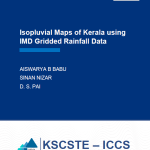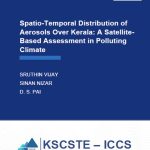The curious case of a strong relationship between ENSO and Indian summer monsoon in CFSv2 model
- Priyanshi Singhai a b c, Arindam Chakraborty a b, Kaushik Jana d, Kavirajan Rajendran e f, Sajani Surendran f, Kathy Pegion c
a Centre for Atmospheric and Oceanic Sciences, Indian Institute of Science, CV Raman Rd, Bengaluru, 560012, Karnataka, India
b Divecha Centre for Climate Change, Indian Institute of Science, CV Raman Rd, Bengaluru, 560012, Karnataka, India
c School of Meteorology, University of Oklahoma, 120 David L Boren Blvd, Norman, 73072, OK, USA
d Mathematical and Physical Sciences Division, Ahmedabad University, Commerce Six Roads, Naranpark Society, Navrangpura, Ahmedabad, 380009, Gujarat, India
e Kerala State Council for Science, Technology and Environment (KSCSTE), Institute for Climate Change Studies (KSCSTE-ICCS), Deepthi Nagar Road Kanjikuzhi, Kottayam, 686004, Kerala, India
f CSIR Fourth Paradigm Institute (CSIR-4PI), NAL Belur Campus Wind Tunnel Road, Bengaluru, 560037, Karnataka, India
Abstract
An ensemble of forecasts is necessary to identify the uncertainty in predicting a non-linear system like climate. While ensemble averages are often used to represent the mean state and diagnose physical mechanisms, they can lead to information loss and inaccurate assessment of the model’s characteristics. Here, we highlight an intriguing case in the seasonal hindcasts of the Climate Forecast System version 2 (CFSv2). While all ensemble members often agree on the sign of predicted El Niño Southern Oscillation (ENSO) for a particular season, non-ENSO climate forcings, although present in some of the individual members, are disparate. As a result, an ensemble mean retains ENSO anomalies while diminishing non-ENSO signals. This difference between ENSO and non-ENSO signals significantly influences moisture convergence and Indian summer monsoon rainfall (ISMR). This stronger influence of ENSO on seasonal predictions increases ENSO–ISMR correlation in ensemble mean seasonal hindcasts. Thus, this discrepancy in the ENSO–ISMR relationship is not present in the individual ensemble members, considered individually or together (without averaging) as independent realizations. Therefore, adequate care should be taken while evaluating physical mechanisms of teleconnection in ensemble mean predictions that can often be skewed due to constructive or destructive superposition of different impacts.
https://doi.org/10.1016/j.dynatmoce.2024.101504
Shifts in bioclimatic zones mirror climate change signals in a tropical agriculture-dominated Bharathapuzha River basin of southern Western Ghats (India)
-Sinan Nizara, Jobin Thomasb, P. J. Jainetc d, Dawn Emil Sebastiane, U. Surendranc f, Balaji Narasimhang, K. P. Sudheerg h i
a KSCSTE-Institute for Climate Change Studies, Kottayam, India
b Department of Geology and Geological Engineering, University of Mississippi, Oxford, Mississippi, USA
c KSCSTE-Centre for Water Resources Development and Management, Calicut, India
d Department of Civil Engineering, Indian Institute of Technology Palakkad, Palakkad, India
e School of Environment and Sustainability, Indian Institute for Human Settlements, Bengaluru, India
f ICAR-National Bureau of Soil Survey and Land Use Planning, Nagpur, India
g Department of Civil Engineering, Indian Institute of Technology Madras, Chennai, India
h Department of Agricultural and Biological Engineering, Purdue University, West Lafayette, Indiana, USA
i Kerala State Council for Science Technology and Environment, Thiruvananthapuram, India
Abstract
Assessing anthropogenic climate change in a regional context is challenging due to the spatial heterogeneity of climatic variables and is more complicated than at the global scale. Especially in the Tropics, such spatial variations are expected to increase, warranting the identification of homogeneous climatic zones for assessing regional climate change. The present study explores the ability of bioclimatic variables in defining regional climatic zones, and the detection of climate change therein. We hypothesize that the identification of homogeneous climatic zones based on bioclimatic variables could be an effective approach rather than the conventional extreme climate-based indices to identify climate change signals. To demonstrate the hypothesis, bioclimatic variables representing the generalized climatic characteristics of a tropical river basin were derived from observed gridded datasets of rainfall and temperature. Clusters of homogeneous climatic zones were identified, and their temporal variations were analysed to examine the existence of climate change. The results indicate that despite the spatial heterogeneity in extreme climate-based indices, the bioclimatic variables-based approach renders a meaningful representation of the regional climatic pattern. Investigation of bioclimatic zones of the study area helped to identify a shift in its climatic zones with a slant towards drier conditions. Further, future changes in climatic zones were identified from 13 different GCMs that participated in the CMIP6, projecting drier conditions over the basin, with varying spatial extend based on future emission scenarios. The study significantly contributes towards the identification of climatologically fragile regions in changing climate, which is an essential component in developing any regional climate change adaptation and mitigation strategy.
DOI https://doi.org/10.1002/joc.8535
Evolution of Antarctic Sea Ice Ahead of the Record Low Annual Maximum Extent in September 2023
-Babula Jenaa, S. Kshitijaa, C. C. Bajishb, John Turnerc, Caroline Holmesc, Jeremy Wilkinsonc, Rahul Mohana, M. Thambana
a National Centre for Polar and Ocean Research, Ministry of Earth Sciences, Vasco da Gama, India
b KSCSTE-Institute for Climate Change Studies, Kottayam, India
c British Antarctic Survey, Natural Environment Research Council, Cambridge, UK
Abstract
The 2023 Antarctic sea ice extent (SIE) maximum on 7 September was the lowest annual maximum in the satellite era (16.98 × 106 km2), with the largest contributions to the anomaly coming from the Ross (37.7%, −0.57 × 106 km2) and Weddell (32.9%, −0.49 × 106 km2) Seas. The SIE was low due to anomalously warm (>0.3°C) upper-ocean temperatures combined with anomalously strong northerly winds impeding the ice advance during the fall and winter. Northerly winds of >12 ms−1 in the Weddell Sea occurred because of negative pressure anomalies over the Antarctic Peninsula, while those in the Ross Sea were associated with extreme blocking episodes off the Ross Ice Shelf. The Ross Sea experienced an unprecedented SIE decrease of −1.08 × 103 km2 d−1 from 1 June till the annual maximum. The passage of quasi-stationary and explosive polar cyclones contributed to periods of southward ice-edge shift in both sectors.
DOI https://doi.org/10.1029/2023GL107561
Occurrence of an unusual extensive ice-free feature within the pack ice of the central Weddell Sea, Antarctica
-Babula Jenaa, John Turnerb, Tylei Reeves-Francoisb, C. C Bajishc, Caroline Holmesb, Thomas Caton Harrisonb, Tony Phillipsb, & Zhaomin Wangd
a National Centre for Polar and Ocean Research, Ministry of Earth Sciences, Goa, India
b British Antarctic Survey, Natural Environment Research Council, Cambridge, UK
c KSCSTE - Institute for Climate Change Studies, Kottayam, India
d Southern Marine Science and Engineering Guangdong Laboratory (Zhuhai), Zhuhai, China
Abstract
We investigate an unusual extensive ice-free feature (EIF) within the pack ice that developed in the central Weddell Sea in December 1980 on the edge of the multi-year sea ice off the east coast of the Antarctic Peninsula. The EIF was first apparent on satellite imagery on 8 December 1980 and expanded until it reached its largest areal extent of ~5.4 × 105 km2 on 26 December. The combined influences of near-record strength ( ~ 15 ms−1) cold winds from the Antarctic continent (transporting sea ice northward and creating an area of thin ice), increased shortwave radiation and net heat flux into the ocean, passage of deep polar storms, and the upwelling of high saline warm water led to the opening of this unique EIF. It is still the largest ice-free feature within the pack ice resembling a polynya observed in the central Weddell Sea during the satellite era, contributing significantly to the 1981 Weddell Sea sea ice extent minimum of 0.793 × 106 km2, the lowest on record. The development mechanism of this EIF was different from the 1970’s Weddell open ocean polynya which occurred within the winter sea ice cover through enhanced ocean convection.
Advances in surface water hydrology research in India
- Tejasvi Chauhana, R. Gowrib, Subimal Ghosha c, & P. P. Mujumdara c
a Department of Civil Engineering, Indian Institute of Technology Bombay, Mumbai, 400076, India
b KSCSTE - Institute for Climate Change Studies, Kottayam, Kerala, 686004, India
c Interdisciplinary Program in Climate Studies, Indian Institute of Technology Bombay, Mumbai, 400076, India
Abstract
India has a growing water crisis fueled by global warming and a rising population. There is an urgent need for accurate water availability assessments and sustainable water management strategies for urban and rural areas. This can be achieved by developing novel decision-making tools for effective water resource management by improving the hydrological models and our understanding of hydrological processes. The changing climate adds complexity to hydrological processes, necessitating accurate modelling and impact assessments to build climate change-resilient water resource systems. This review examines the advancements in hydrological process understanding and surface hydrological modelling in India from 2019 to 2023. Recent years have witnessed substantial contributions from the Indian hydrology community, which include quantifying climate change impacts on water and carbon cycle at a basin scale, improvements in hydrological modelling and forecasting extremes, the introduction of novel physics-based data-driven approaches, urban flood modelling and the development of first-ever state-of-the-art flood early warning system among other notable climate services. In addition, the idea of studying natural systems as coupled human-natural systems has gained prominence in India. This review aims to provide insights into recent developments in surface water hydrology in India and highlight the potential future avenues of research that can uplift water resources management in India.
Chromophoric dissolved organic matter traces seasonally changing coastal processes in a river-influenced region of the western Bay of Bengal
- Sudarsana Rao Pandia b, Nittala Subrahmanya Sarmaa,Chiranjeevulu Gundalaa, Veera Harikrishnachari Narojua,Aneesh Anandrao Lotlikerc, Chevooruvalappil Chandran Bajishd,& Sarat Chandra Tripathyb
a Marine Chemistry Laboratory, Andhra University, Visakhapatnam, 530003, India
b National Centre for Polar and Ocean Research, Ministry of Earth Sciences, Vasco-da-Gama, Goa, 403804, India
c Indian National Centre for Ocean Information Services, Ministry of Earth Sciences, Hyderabad, 500090, India
d KSCSTE-Institute for Climate Change Studies, Kottayam, 686004, India
Abstract
The optical characteristics of colored dissolved organic matter (CDOM) serve as a convenient tool for evaluating coastal processes, e.g., river runoff, anthropogenic inputs, primary production, and bacterial/photochemical processes. We conducted a study on the seasonal and spatial variability of absorbance and fluorescence characteristics of CDOM and nutrients in the coastal waters near the Gauthami estuary of River Godavari, the largest peninsular river of India, for a year. The surface aCDOM(350) showed a significant inverse relation with salinity in the coastal region, indicating a conservative mixing of marine and terrestrial end members. The aCDOM(350) was not conservative in the offshore (100 m isobath) waters due to enrichment by secondary sources. Seasonal variability in optical properties indicated diverse sources for CDOM, as revealed by principal component analysis. The excitation-emission matrix (EEM) spectra followed by parallel factor analysis (EEM-PARAFAC) revealed four distinct fluorophores. The tyrosine (B) fluorophore showed a predominant increase in the post-monsoon season (October to January), while tryptophan (T) was relatively more enriched, coincident with nutrient enrichment and transparency increase during the early monsoon phase (July). The biological index (BIX), which reflects recent photosynthetic activity, also displayed relatively higher values during the early monsoon. The humic fluorophores A and M, and humification index (HIX) were relatively enriched during the later phase of monsoon (July–October). HIX was > 4 in a few samples of the offshore region (100-m isobath) and indicated a probable contamination from drill-mud (bentonite) used in hydrocarbon exploration. During the monsoon, the relationship between T and B with CDOM was not evident due to the masking of B fluorescence in intact protein. However, during the post-monsoon (POM) and pre-monsoon (PRM) periods, this masking effect was not observed, likely due to protein degradation via bacterial and photochemical processes, respectively. Temporal variability in nutrients indicated that high ammonium levels were produced during POM (OM bacterial degradation), and high nitrite levels were observed during PRM (due to primary production). This study provides foundational insights into the use of CDOM for understanding the impact of diverse environmental, river discharge, and anthropogenic factors on coastal ecosystems.
Chapter 3 - Hydrological setting of Kerala
- Jobin Thomasa, Sinan Nizarb, A.N. Rohithc, P.J. Jainetd e, Dawn Emil Sebastiand f, Vamsi Krishna Vemag, K.P. Sudheerh i
a Department of Geology and Geological Engineering, University of Mississippi, Oxford, MS, United States
b KSCSTE—Institute for Climate Change Studies, Kottayam, Kerala, India
c Department of Agricultural and Biological Engineering, Pennsylvania State University, University Park, PA, United States
d KSCSTE—Centre for Water Resources Development and Management, Kozhikode, Kerala, India
e Department of Civil Engineering, Indian Institute of Technology Palakkad, Palakkad, Kerala, India
f School of Environment and Sustainability, Indian Institute for Human Settlements, Bengaluru, India
g Department of Civil Engineering, National Institute of Technology, Warangal, Telangana, India
h Department of Civil Engineering, Indian Institute of Technology Madras, Chennai, Tamil Nadu, India
i Kerala State Council for Science Technology and Environment, Thiruvananthapuram, Kerala, India
Abstract
A comprehension of the diversity of water resources and hydrological characterization of Kerala is of utmost importance for sustainable management of the water resources and conservation of the aquatic environment. The reliance on the water resources of Kerala for agriculture, power generation, industry and tourism sectors underscores the critical importance of the hydrological characterization. Within this chapter, an in-depth exploration of the hydrological setting of Kerala is undertaken, which covers the physical environment, rivers, watersheds, climate and hydrological disasters, as well as the challenges to sustainable water resource management. The hydrological data presented in this chapter and their synthesis establish a solid foundation for researchers, planners and decision-makers to remodel efficient water management and planning strategies. It also serves as a valuable platform for developing robust disaster management plans, early warning systems and adaptive strategies aimed at enhancing climate resilience and minimizing the socio-economic impacts linked to hydrological disasters.
https://doi.org/10.1016/B978-0-323-95606-2.00011-5
Chapter 8 - From science to policy—Toward an approach linking extreme rainfall events to climate resilience and policy development: A case study from Kerala, India
- K.P. Sudheera b c, Jobin Thomasd, P.J. Jainete f, Sinan Nizarg, Sahila Beegumh, Dawn EmilSebastiane,Jesnaa,D.S.Paig
a Department of Civil Engineering, Indian Institute of Technology Madras, Chennai, India
b Department of Agricultural and Biological Engineering, Purdue University, West Lafayette, IN, United States
c Kerala State Council for Science Technology and Environment, Thiruvananthapuram, India
d Department of Geological and Mining Engineering and Sciences, Michigan Technological University, Houghton, MI, United States
e KSCSTE-Centre for Water Resources Development and Management, Calicut, India
f Department of Civil Engineering, Indian Institute of Technology Palakkad, Palakkad, India
g KSCSTE-Institute for Climate Change Studies, Kottayam, India
h Nebraska Water Center, part of the Robert B. Daugherty Water for Food Global Institute, University of Nebraska, Lincoln, NE, United States
Abstract
The western slopes of the southern Western Ghats (i.e., Kerala State, India) experienced unprecedented and widespread extreme rainfall events (EREs) during the Indian summer monsoon season of the years 2018 and 2019, causing extensive flooding (in the lowlands and midlands) and numerous landslides (in the highlands) across the region. In a warming climate, the occurrence of such EREs, steered by the atmospheric conditions, is generally expected. While there were a lot of speculations, theories, and scientific perspectives explaining the reasons for the occurrence of these phenomena, a concrete and scientific validation was still lacking. The context warranted a comprehensive multidisciplinary investigation with special emphasis on hydrology, atmosphere, and anthropogenic activities. This chapter summarizes the multidisciplinary investigations of various factors ranging from global climate change to local anthropogenic activities to ascertain the causes and responses to the floods and landslides in the aftermath of heavy rainfall in August 2018 and August 2019 in the Kerala State, India. The information was synthesized after the analysis of primary and secondary data, and simulation-based results. This chapter initially describes a detailed analysis, and assessment of the reasons for the occurrence of such EREs and their major causative factors. In the subsequent sections, reviews of regional impact of such EREs leading to floods and landslides are described. Recommendations to frame appropriate policy responses are formulated based on the survey of previous literature and ancillary information, observations during the field visits, interaction/discussion with scientific experts, administrators at different levels, and community. This study aims at assisting policy makers to formulate appropriate policies for mitigating the negative impact of devastating natural hazards such as floods and landslides associated with extreme hydro-metrological events in the future.
Exploring the Dynamics of Antarctic Sea Ice over Four Decades Using Geospatial Technology
- Niladri Sahaa, Babula Jenab, C. C. Bajishb c, Sandipan Dasa, Binaya Kumar Pattnaika, & Uday Chatterjeed
a Symbiosis Institute of Geoinformatics, Symbiosis International (Deemed University), Pune, Maharashtra, India
b National Center for Polar and Ocean Research, Vasco Da Gama, Goa, India
c KSCSTE-Institute for Climate Change Studies, Kottayam, India
d Department of Geography, Bhatter College, Dantan, (Affiliated to Vidyasagar University), Paschim Medinipur, West Bengal, India
Abstract
The present climate change phase has had contrasting effects on sea ice in the Arctic and Antarctic. There has been a startling loss of ancient ice in the Arctic, leading to a dramatic reduction in sea-ice area and thickness. No evidence of analogous shifts in the Antarctic has been found till 2014. This work seeks to understand the issue presented in the title by synthesizing relevant research from the literature. This chapter begins by reviewing important recent records and defining major geographical and meteorological aspects and sea-ice characteristics of the two polar areas. More specifically satellite data revealed that the Antarctic sea-ice extent is increasing at a rate of 0.7 ± 0.4 percent decade−1 (1979–2018). On the contrary, the Arctic sea ice showed a decreasing trend as an optimal consequence of global warming at a rate of −4.8 ± 0.2 percent decade−1 (1979–2018). This study explored 40 years (1979–2018) of Antarctic sea-ice remote sensing data to explore its overall and regional trends. Anomaly has been computed over the previous 3 years (2015, 2016, 2017, and 2018) to determine what form of anomaly has arisen in the Antarctic area. The findings of this study have the potential to understand the drivers and dynamics of Antarctic sea ice and contribute to future climate projections.
DOI:doi.org/10.1007/978-3-031-44397-8_3
Chapter 3 - Hydrological setting of Kerala
- Jobin Thomasa, Sinan Nizarb, A.N. Rohithc,P.J. Jainetd e, Dawn Emil Sebastiand f,Vamsi Krishna Vemag, K.P. Sudheerh i
a Department of Geology and Geological Engineering, University of Mississippi, Oxford, MS, United States
b KSCSTE—Institute for Climate Change Studies, Kottayam, Kerala, India
c Department of Agricultural and Biological Engineering, Pennsylvania State University, University Park, PA, United States
d KSCSTE—Centre for Water Resources Development and Management, Kozhikode, Kerala, India
e Department of Civil Engineering, Indian Institute of Technology Palakkad, Palakkad, Kerala, India
f School of Environment and Sustainability, Indian Institute for Human Settlements, Bengaluru, India
g Department of Civil Engineering, National Institute of Technology, Warangal, Telangana, India
h Department of Civil Engineering, Indian Institute of Technology Madras, Chennai, Tamil Nadu, India
i Kerala State Council for Science Technology and Environment, Thiruvananthapuram, Kerala, India
Abstract
A comprehension of the diversity of water resources and hydrological characterization of Kerala is of utmost importance for sustainable management of the water resources and conservation of the aquatic environment. The reliance on the water resources of Kerala for agriculture, power generation, industry and tourism sectors underscores the critical importance of the hydrological characterization. Within this chapter, an in-depth exploration of the hydrological setting of Kerala is undertaken, which covers the physical environment, rivers, watersheds, climate and hydrological disasters, as well as the challenges to sustainable water resource management. The hydrological data presented in this chapter and their synthesis establish a solid foundation for researchers, planners and decision-makers to remodel efficient water management and planning strategies. It also serves as a valuable platform for developing robust disaster management plans, early warning systems and adaptive strategies aimed at enhancing climate resilience and minimizing the socio-economic impacts linked to hydrological disasters.
https://doi.org/10.1016/B978-0-323-95606-2.00011-5
Effect of crop management practices on water balance components in an agricultural catchment
-Jose George, Sinan Nizar, Gowri R, Aiswarya B. Babu, C. C. Bajish and K. P. Sudheer

Isopluvial Maps of Kerala using IMD Gridded Rainfall Data
-Aiswarya P Babu, Sinan Nizar, D S Pai

Spatio-Temporal Distribution of Aerosols Over Kerala: A SatelliteBased Assessment in Polluting Climate
-Sruthin Vijay, Sinan Nizar, D S Pai

Kerala Climate Statement 2023

Kerala Climate Statement 2022

Kerala Climate Statement 2021



